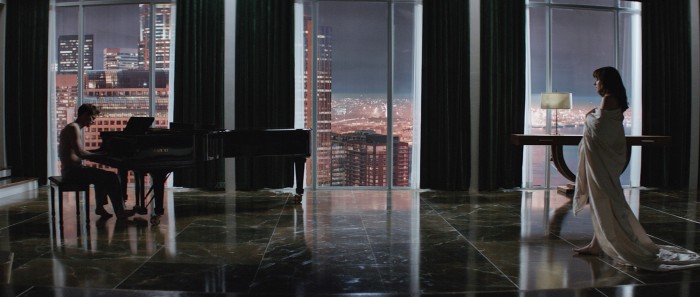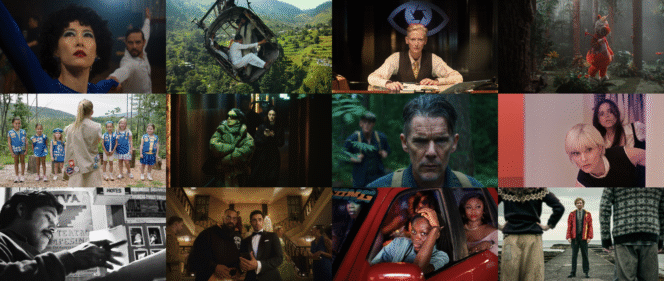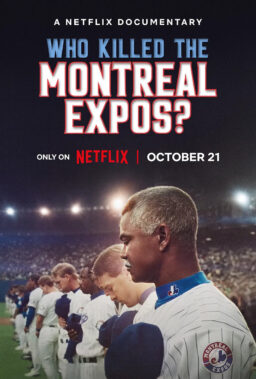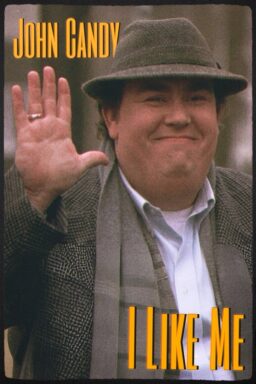Consensus forms around
a film festival like it does a WWE pay-per-view. Though how the main event pans
out might pave way for discussions on the wider critical landscape and deeper
cultural problems, opinions tend to come from a limited if excited perspective,
focusing primarily on the here-and-now: it’s been a terrible year, it’s been a
good year. Either way, such assessments are ordinarily based on a necessarily
small tally of films—which might in itself be no bad thing.
If Cannes is the
festival circuit’s WrestleMania, then the Berlinale is its Royal Rumble. It’s
not just that these two events nearly coincide (one happens at the end of
January, the other across the second week of February), and it’s not just that
each is the annual starting point of a prolonged succession of hyperbolic
spasms in its respective field. It’s also that, this year, a photographic
snapshot from either event might have been mistaken for the other, because the
mad, hysterical scramble for one press screening in particular at the 65th
Berlin International Film Festival was not unlike the multi-man showdown that
concludes one of the most anticipated events in sports entertainment, in which
30 wrestlers compete over the course of an hour or so to win a shot at the
world championship at a later date. It’s every challenger for themselves.

As indeed it was for
the first publicized press screening of “Fifty Shades of Grey”, at which
many trade reporters, broadsheet writers and journalists of other hues thought
they could stroll right up and join their pals while colleagues who’d sensibly
camped out for two hours prior were pushed further and further back in line.
Some of these talked down to the one cinema staff member trying to impose order
upon the situation. Others point blank and even aggressively refused to leave
the queue into which they’d so brazenly pushed. “Oh come on, he’s a friend,”
protested defenders of the guilty. But the problem is that film critics happen
to be an incestuous bunch, and everyone has friends further up the line.
The prize for such
unacceptably rude behavior was one of 380 leather seats in the German capital’s
CineStar IMAX, just a short walk away from the steely glitz of Potsdamer Platz.
The havoc—which can easily be overstated in a world in which much worse things
happen, but here we are—was a sad and revealing reflection of how messy and
fussy things can get when people lose sight of the profession and lifestyle
that has taken them away from everyday decency and into the foul pit of entitlement.
Critics are people too, but I sometimes wish they weren’t so keen to forget
this basic truism.
Universal chose not to
pay for crowd control before the event but did hire two security men to walk
back and forth along the rear and down the sides of the “Fifty Shades of Grey”
screening in order to enforce a no cell phones policy, presumably to deter
piracy or some other delinquent act. Hearing, seeing and even feeling these
guys marching about the cinema only seemed to add to the sense that this film
is a calculated, pre-packaged commodity that’s creating its own anticipation by
convincing everyone that they need to have it regardless of any vacuity found
therein. It’s like a miserably soulless nightclub decked with immaculate floors
and boasting a chic décor, where nobody inside is having any fun, but to leave
would cause some kind of catastrophic crisis à la “The Truman Show.”

In Berlin, at least
you can’t go too long without seeing or talking about the actual films. The
overly designed—or make that numbingly functional—craft of “Fifty Shades of
Grey” is a far cry from Peter Greenaway’s new feature and competition entry “Eisenstein
in Guanajuato.” Though it’s true that the 72-year-old director has been
banging on about the same ideas for decades now—the tyranny of the rectangular
frame, movies as illustrated text, cinema is dead, blah blah blah—one can’t
deny that he’s persistent in following his lasting intellectual, philosophical
and artistic queries with experimental rigor. This isn’t to validate
Greenaway’s pursuits as of inherently higher value than those of “Shades”
director Sam Taylor-Johnson, but his employment of cinema as some kind of
bedazzlingly pedagogic weapon shows little regard for commercial appeal.
In his latest,
Finnish-born Elmer Bäck plays a 33-year-old Sergei Eisenstein, who comes to
Mexico in 1931 to make “Que Viva Mexico!”, funded by a group of leftists led by
Mr. and Mrs. Upton Sinclair. During the trip, the pioneer of Soviet montage
falls in love with his guide Palomino Cañedo (Luis Alberti), an instructor in
comparative religion who takes the Russian’s virginity and helps reinvigorate
his creative sensibilities. Atop this romance—which is itself presented with a
rascally, there-you-have-it wink—Greenaway both pushes and reins in his recent
aesthetic preferences. On the one hand, “Eisenstein” is comparatively
pared-down in wake of the director’s short contribution to the portmanteau
triptych “3x3D,” but on the other there are the usual ingredients: a restlessly
episodic narrative, Brechtian distanciation, frames within frames, reflections
and repetitions, genital vulgarities, a matter-of-fact treatment of depravity,
a sense of humor that’s at once juvenile and highbrow, and so on.
While the film doesn’t
seem to worry too much about veering between ugly and beautiful (often in the
same moments), it did contain the single most exhilarating filmic trick of the
festival. The scene involves an argument, in a pillared restaurant, between
Eisenstein and his financial backers. Characters talk over one another and
background extras come and go with a distracting choreography. Just as we’re
beginning to get our bearings, though, Greenaway and cinematographer Reinier
van Brummelen’s camera, which has all the while been crabbing along a perpetual
sideways track, begins to capture the scene from a perpendicular angle, still
moving in the same motion and seemingly without stopping. The trick is in the
transparent edits that occur each time the camera moves behind a stone column
in the foreground. In design it’s one of those simple but clever little
sleights of hand, yet in execution the cine-spatial dismantlement is
spectacular.
Spectacles of this
kind can be hard to come by in cinemas these days. Certainly, something
intangible seems to have shifted, perhaps irrevocably, in the ways a film is
made and in the purpose it aims to satisfy. To begin with, films appear to have
lost their color over the last two decades. One senses that, rather than
confronting the present economic crisis with any sort of deep engagement,
filmmakers have come to represent our predicament by means of the easiest
approximation they have at hand: color, or a lack of it. I, for one, am fed up
with the sheer volume of humorless works being made today, but the misery is
only heightened by a poor investment in actual color. I don’t think it’s to do
with digital as much as the exponential pressure to aspire to an unmatched
verisimilitude. The problem is that we’re mistaking an increasingly monochrome
palette as a fair reflection of this dour world, when actually it’s as vibrant
as it ever has been.
Nostalgic joys abound,
then, for this year’s Technicolor retrospective. This, a fine assortment of
obvious as well as overlooked films from the Technicolor canon, boasted the
likes of “Singin’ in the Rain”, “Gentlemen Prefer Blondes” and “Broken
Arrow.” The most curious of the bunch that I saw was “Yolanda and the
Thief”, Vincente Minnelli’s 1945 musical starring Fred Astaire and Lucille
Bremmer. A young woman (Bremmer) is taken from a convent and told she has
inherited a vast estate in some weird, fantastical land. Astaire, a thief,
plots to steal her fortune by posing as her guardian angel. The pair belatedly
fall in love. Such a minimal synopsis does very little to suggest the sheer
nonsense at work: very little of this fanciful film holds together emotionally,
dramatically or logically. Also at work, however, is a preposterous color
palette so exceptionally sharp it seems almost to be stereoscopic.
Speaking of which, an
amendment, of sorts. Earlier this week I referred to Wim Wenders’s use of 3D in
his dramatic misfire “Every Thing Will Be Fine” as purposeless. Upon
reflection this seems to be as unfair as it was knee-jerk. In his capsule at
Keyframe Daily, David Hudson writes: “There’s nothing showy about any of the
shots, but you’ve got to admire the balance and simplicity in, for example, a
medium shot of James Franco, nudged a bit to the left and set against the
evening sky and, to the right, a street lamp, and between them, further back,
receding from the depth of field, a church tower. That’s great work in 2D; it’s
truly something else in 3D.” I’m now inclined to agree with these sentiments,
and in any case one has to praise Wenders’s attempts to strengthen and draw
attention to the ineluctable supremacy of the cinematic image. And I like the
idea that there’s room for spectacle in a story as mundane as this film’s.

One other adjustment
concerns Radu Jude’s competition entry “Aferim!” Unfolding over a few
days in a politically and racially charged 1830s Romania, it sees a gendarme
(Teodor Corban) journeying across feudalist Wallachia in search of a gypsy
fugitive who has run away from the aristocrat who owns him. Jude’s third
feature (fourth, if you view his hour-long “Film For Friends” as such) is a
detailed and in many ways idiosyncratic snapshot of the time at hand. I have
already written elsewhere on the film, but a number of fellow critics voiced
qualms at my suggestion that in being set in such a visibly different
socioeconomic system, the film’s authentic period representation of how gypsies
were then treated (they were tantamount to slaves, as one character notes)
reminds us of how dissimilar things are today—and more importantly, how much
better they can still become.
What I meant but
failed to note was that, of course, the Romany population still faces terrible
social prejudices today that are further enabled by political castigation, in
Romania and throughout Europe. But what I do think “Aferim!” does very well is
to undercut the highly conservative values upheld by the propertied classes in
the film. “The world will stay on as it is. You can’t change it, try as you
might.” Try as we did and try as we might! This—whose cinematography, by the
way, somehow possesses a vibrant color despite the whole thing being in
black-and-white—is a profitable departure for Romanian filmmakers in its turn
to a point in that nation’s history more remote than its recent past. History
never did end.

A final word, then, on
what was perhaps the best film to premiere in Berlin last week. This was Alex
Ross Perry’s fourth feature, “Queen of Earth”, in which Elisabeth Moss
and Katherine Waterston play two seemingly close pals whose annual catch-up at
a summer home owned by the latter’s parents is charged with jealousy,
suspicion, selfishness and petty bickering. Moss’ character, who has recently
been ditched by her boyfriend and lost her dad to suicide, arrives at the
lakeside spot looking for a consoling shoulder from her friend, but the latter
seems too consumed by her own romantic developments with a neighbor (Patrick
Fugit). Through flashbacks, we see events of the previous summer, and how the
tiny frissons of an extended double date can have protracted and dormant
consequences.
Talk of color and
nostalgia is equally fitting for this film. Sean Price Williams’s Super 16mm
cinematography is again, as in Perry’s last feature “Listen Up Philip”, a key
element in drawing one into the film’s lovely, grainy textures. But there’s
also a retro feel to the film as a whole, not only in the flamboyant text that
periodically divides the story into days of the week, and not only in the
weird, elusive performances from Moss and Waterston that seem like they’re lost
from another, more nuanced age, but also in the way in which the film expertly
channels the likes of Bergman, Cassavetes, somber-phase Woody Allen and Lynch.
For the latter especially, look out for a lengthy conversation that continues,
and continues, under Keegan DeWitt’s haunting, tonally disconcerting score and
the rotating, jitters-inducing blades of a ceiling fan. As with the Malick film
that premiered here this week, I’d like to see it again.











